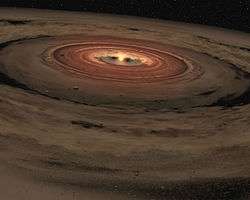OTS 44
OTS 44 is a free-floating planetary-mass object or brown dwarf located at 550 light-years (170 pc) in the constellation Chamaeleon near the reflection nebula IC 2631. It is among the lowest-mass free-floating substellar objects, with approximately 11.5 times the mass of Jupiter, or approximately 1.1% that of the Sun.[2][4] Its radius is not very well known and is estimated to be 23–57% that of the Sun.[1][3]
 An artist's concept of OTS 44's dust disk | |
| Observation data Epoch J2000.0 Equinox J2000.0 | |
|---|---|
| Constellation | Chamaeleon |
| Right ascension | 11h 10m 11.5s |
| Declination | −76° 32′ 13″ |
| Characteristics | |
| Spectral type | M9.5[1] |
| Astrometry | |
| Distance | 554 ly (170 pc) |
| Details | |
| Mass | 0.011[2] M☉ |
| Radius | 0.23[1]–0.57[3] R☉ |
| Luminosity | 0.0013[1]–0.0024[3] L☉ |
| Temperature | 1,700[2][3]–2,300[1] K |
| Database references | |
| SIMBAD | data |
OTS 44 was discovered in 1998 by Oasa, Tamura, and Sugitani as a member of the star-forming region Chamaeleon I.[5][6] Based upon infrared observations with the Spitzer Space Telescope and the Herschel Space Observatory, OTS 44 emits an excess of infrared radiation for an object of its type, suggesting it has a circumstellar disk of dust and particles of rock and ice.[1][3][7] This disk has a mass of at least 10 Earth masses.[3] Observations with the SINFONI spectrograph at the Very Large Telescope show that the disk is accreting matter at the rate of approximately 10−11 of the mass of the Sun per year.[3] It could eventually develop into a planetary system. Observations with ALMA detected the disk in millimeter wavelengths. The observations constrained the dust mass of the disk between 0.07 and 0.63 M⊕, but these mass estimates are limited by assumptions on poorly constrained parameters.[8]
See also
- SCR 1845-6357, a binary system comprising a red dwarf and a brown dwarf
- Cha 110913-773444, an astronomical object that may be a free-floating planet surrounded by what appears to be a protoplanetary disk
References
- Luhman, K. L.; et al. (February 2005), "Spitzer Identification of the Least Massive Known Brown Dwarf with a Circumstellar Disk", The Astrophysical Journal, 620 (1): L51–L54, arXiv:astro-ph/0502100, Bibcode:2005ApJ...620L..51L, doi:10.1086/428613
- Bonnefoy, M.; Chauvin, G.; Lagrange, A.-M.; Rojo, P.; Allard, F.; Pinte, C.; Dumas, C.; Homeier, D. (2014). "A library of near-infrared integral field spectra of young M-L dwarfs". Astronomy & Astrophysics. 562 (127): A127. arXiv:1306.3709. Bibcode:2014A&A...562A.127B. doi:10.1051/0004-6361/201118270.
- Joergens, V.; Bonnefoy, M.; Liu, Y.; Bayo, A.; Wolf, S.; Chauvin, G.; Rojo, P. (2013). "OTS 44: Disk and accretion at the planetary border". Astronomy & Astrophysics. 558 (7): L7. arXiv:1310.1936. Bibcode:2013A&A...558L...7J. doi:10.1051/0004-6361/201322432.
- Luhmann, K. L.; Peterson, D. E.; Megeath, S. T. (2004). "Spectroscopic Confirmation of the Least Massive Known Brown Dwarf in Chamaeleon". The Astrophysical Journal. 617 (1): 565–568. arXiv:astro-ph/0411445. Bibcode:2004ApJ...617..565L. doi:10.1086/425228.
- Tamura, M.; Itoh, Y.; Oasa, Y.; Nakajima, T. (1998). "Isolated and Companion Young Brown Dwarfs in the Taurus and Chamaeleon Molecular Clouds". Science. 282 (5391): 1095–7. Bibcode:1998Sci...282.1095T. doi:10.1126/science.282.5391.1095. PMID 9804541.
- Oasa, Y.; Tamura, M.; Sugitani, K. (1999). "A Deep Near-Infrared Survey of the Chamaeleon I Dark Cloud Core". The Astrophysical Journal. 526 (1): 336–343. Bibcode:1999ApJ...526..336O. doi:10.1086/307964.
- "Blurring the lines between stars and planets: Lonely planets offer clues to star formation". MPIA Science Release 2013-09. Retrieved 1 September 2014.
- Bayo, Amelia; Joergens, Viki; Liu, Yao; Brauer, Robert; Olofsson, Johan; Arancibia, Javier; Pinilla, Paola; Wolf, Sebastian; Ruge, Jan Philipp; Henning, Thomas; Natta, Antonella (May 2017). "First Millimeter Detection of the Disk around a Young, Isolated, Planetary-mass Object". Astrophysical Journal Letters. 841 (1): L11. Bibcode:2017ApJ...841L..11B. doi:10.3847/2041-8213/aa7046. hdl:10150/624481. ISSN 0004-637X.
External links
- Astronomers Discover Beginnings of 'Mini' Solar System (Spitzer Space Telescope)
- MPIA Science Release 2013-09 - Blurring the lines between stars and planets: Lonely planets offer clues to star formation